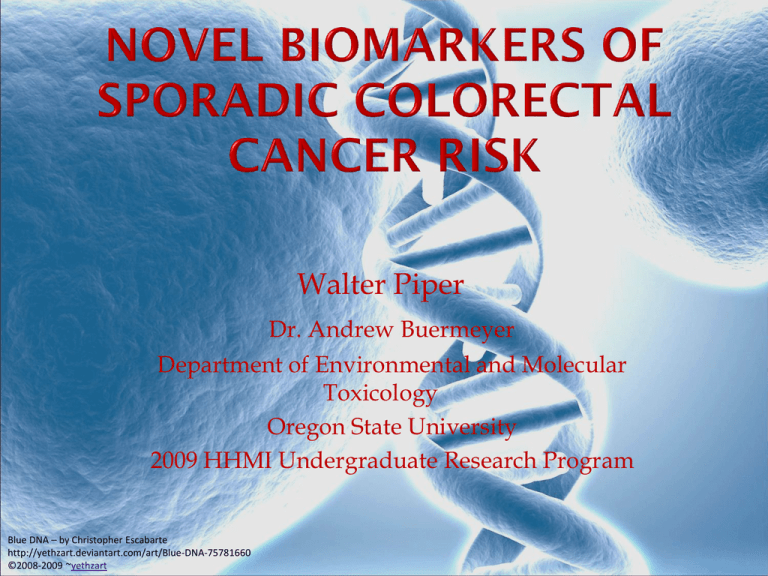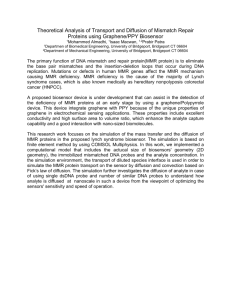Walter Piper
advertisement

Walter Piper Dr. Andrew Buermeyer Department of Environmental and Molecular Toxicology Oregon State University 2009 HHMI Undergraduate Research Program Blue DNA – by Christopher Escabarte http://yethzart.deviantart.com/art/Blue-DNA-75781660 ©2008-2009 ~yethzart Alcohol (+80%-250%) Smoking (+18%) BMI (Body Mass Index) Figure 1 – Colon Cancer and Polyp http://images.medicinenet.com/images/ILLUSTRATIONS/colon_ cancer.jpg MedicineNet.com (+50% in men when BMI>25. Less risk in women) Diet Genetic influence (+200%) A 1st degree relative with the cancer is one of the biggest risk factors. The exact causes of this genetic risk are unknown. Hereditary Sporadic Cases of Colorectal Cancer by type 5% Hereditary Sporadic 95% Figure 2 – Percentage of total cases of CRC by type. Current CRC risk evaluation family history Cytotoxicity assay physical basis to evaluate risk Uses: Large scale studies Individual patient evaluation DNA mismatch repair (MMR) is a complex pathway involved in the maintenance of DNA integrity. In the event that this repair process fails, a mutation will occur, which may lead to cancer. MMR deficiency is linked to hereditary colorectal cancer. Figure 3 – DNA Mismatch Repair http://www.rndsystems.com/mini_review_detail_objectname_MR03_DNADamageResponse.a spx R&D Systems Moderate deficiencies present in the normal range of the population contribute to the genetic risk for sporadic CRC. How can we accurately assess MMR proficiency? Genetically Biochemically Cell-based cytotoxicity assay Figure 4 MMR proteins in DNA-repair and DNA-damage-response pathways Biochemical Society Transactions www.biochemsoctrans.org (2005) 33, 689-693 Biochem. Soc. Trans. Figure 5 – MNNG induced methylation and attempted mismatch repair leading to apoptosis. Use MTS to measure the relative surviving cell fraction following exposure to MNNG. Relative cell survival should correlate with the level of MMR proficiency. Does MMR proficiency correlate with the genetic risk for sporadic CRC? Cell survival is then measured using an MTS Assay. Cells biochemically reduce the tetrazolium compound, MTS, into a colored formazan product that has an absorbance maximum at 490 nm. The amount of formazan dye is determined by absorption of 490 nm UV light in a plate reader. Figure 6 – General reaction for the reduction of a tetrazolium to a formazan. http://en.wikipedia.org/wiki/F ile:Tetrazolium_reduction.png We are using immortalized lymphoblasts from blood samples to measure varying degrees of MMR proficiency in the general population. Differing degrees of MMR proficiency can be characterized by consistent results showing a distinct level of cell survival. Is the assay sensitive and precise enough to measure the slight differences in MMR proficiency? Culture human lymphoblastoid cells Growth concentration: 50,000 – 1,000,000 cells/ml Doubling time: ~21 hours Treat cells in 96-well plates with the harmful mutagen MNNG Cell cultures that are more MMR proficient undergo higher rates of apoptosis because they have a more effective DNA damage signaling pathway. MTS assay is used to measure relative cell survival. Currently establishing conditions for cytotoxicity measurement using MTS assay, so an accurate cell count can be determined based on signal reading. What kind of media is best? Standard RPMI media, media without phenol red, or media buffered with 25 mM HEPES? Signal vs. Cell number at 2.5 hours 2.5 2 N-media 1.5 Signal P-media 1 B-media 0.5 Figure 7 – Signal in plate reader vs. number of cells in a well. 0 0 50000 100000 150000 200000 Number of cells 250000 300000 Validate assay with initial set of clinical samples. Study the normal range of MMR proficiency in the general population. Large-scale studies could also be done to definitively link MMR to sporadic CRC risk. Howard Hughes Medical Institute Dr. Andrew Buermeyer Vidya Schalk Sarah Ferrer Anneka Wickramanayake Dr. Kevin Ahern


